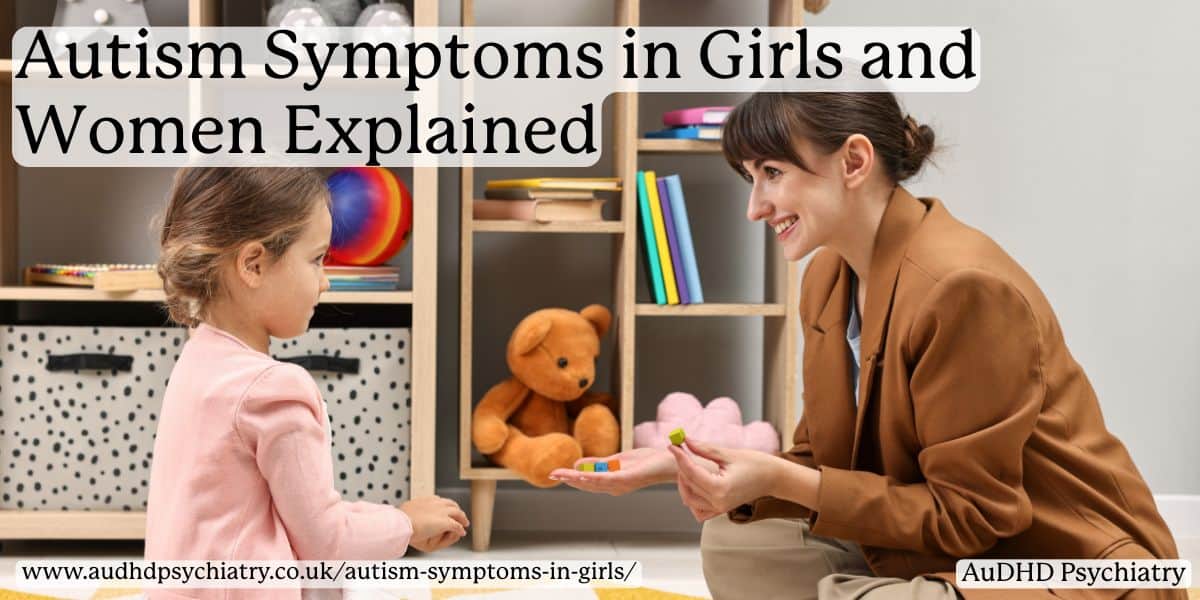
Did you or someone you know grow up feeling “different?” Many girls and women experience this. They could be with social interactions, eye contact, or unspoken social rules, yet never understand why. For decades, autism symptoms in girls have been misunderstood or overlooked, often mistaken for shyness, anxiety, or perfectionism.
While autism is a neurodevelopmental disorder, it presents differently in females than in boys. Girls often learn to “mask” their autistic traits, copying others to fit in, which can delay diagnosis until adulthood. Recognising these differences is crucial for providing early support, emotional understanding, and access to proper assessment.
This guide explains how female autism appears across different ages—from early childhood to adulthood—highlighting the subtle signs that healthcare professionals, parents, and teachers should know. If these signs sound familiar and you or a loved one would like help finding answers, consider booking a confidential consultation through AuDHD Psychiatry.
Understanding Autism in Female Children
Recognising autism symptoms in girls can be difficult because they often present differently from boys. Autistic children, especially girls, tend to show subtle variations in developmental milestones, social communication, and emotional regulation. What may appear as shyness or sensitivity can, in some cases, reflect early autistic traits.
Autism in Young Children and Developmental Milestones
In early childhood, autism may appear through:
- Delays in language development or speech patterns.
- Limited or absent pretend play.
- Repetitive movements or routines, such as lining up toys.
- Difficulty with eye contact or social engagement.
Some young children may also develop intense interests or need predictable routines to feel safe. These differences can seem mild, making it easy to overlook early symptoms of autism.
Autism in Older Children and Social Skills
By the time autistic girls enter school, many begin to adapt socially by copying classmates—a behaviour known as “masking.” They may follow rules closely, appear cooperative, and achieve academically, which can hide their challenges with social communication and body language. However, the effort to keep up often leads to fatigue, anxiety, or emotional burnout.
Teachers and healthcare professionals may not always recognise these signs, as girls often appear socially capable despite internal struggles. Early awareness is essential. Parents who notice developmental differences should speak to a GP or specialist in developmental disorders.
Early Signs of Autism in Girls (Ages 1–4)
Early signs of autism in young girls can be subtle and easily overlooked. During these early years, language delays, reduced eye contact, or limited response to their name may appear. Some girls show less interest in pretend play, preferring repetitive activities such as arranging toys or focusing on specific sounds or movements.
Unlike boys, autistic girls may appear socially aware but struggle to engage spontaneously. They might mimic gestures or routines rather than initiate play. These early differences are often mistaken for personality traits, which can delay an early diagnosis. Recognising these patterns early allows parents and professionals to plan timely intervention and support.
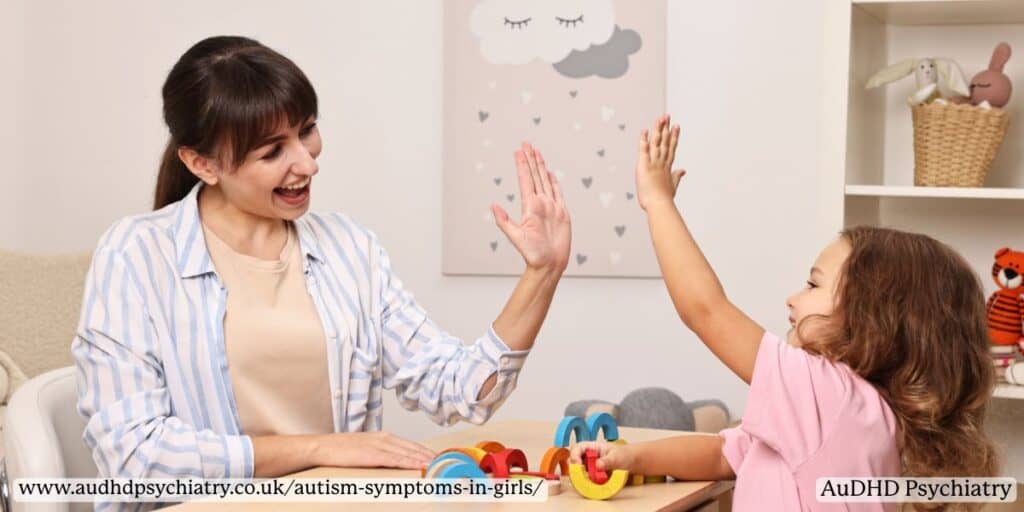
Autism Traits in School-Age Girls (Ages 5–10)
When autistic girls reach school age, their social interactions often become more complex. Many can follow classroom rules and maintain friendships on the surface, yet struggle to understand social cues, facial expressions, and body language.
They may experience sensory input challenges such as becoming easily overwhelmed by noise, lights, or crowded spaces. Some engage in repetitive or “stimming” behaviours, like tapping pencils or twirling hair, to regulate emotions.
Teachers may not recognise these subtle autistic traits, especially when academic performance seems typical. However, emotional distress, perfectionism, or social withdrawal can indicate underlying communication and sensory difficulties that need compassionate understanding and tailored support.
Autism in Girls: How It Manifests
The way autism symptoms in girls appear can differ significantly from traditional descriptions based on boys. While both share the same core traits, for example, differences in social communication, restricted interests, and sensory processing, girls often express these in more subtle and socially adapted ways. Understanding these nuances helps parents, teachers, and healthcare professionals identify female autism earlier and more accurately.
Subtle and Overlooked Autism Traits in Girls
As we’ve mentioned, many autistic females learn to observe and imitate others to fit in. Masking allows them to hide visible autistic traits, such as difficulty with eye contact, literal interpretation of language, or repetitive behaviours [1]. However, maintaining this façade can lead to exhaustion, anxiety, and depression over time.
Unlike boys, who may display outward signs like repetitive movements or disruptive behaviour, autistic girls often internalise their struggles. They may spend playtime observing rather than participating, prefer one-to-one friendships, or express emotions through perfectionism and self-criticism. Because these traits are socially acceptable, they often go unnoticed by adults.
Common Female Autistic Traits
While every person experiences autism differently, many female autistic traits include:
- Difficulty interpreting social cues, tone of voice, and facial expressions.
- Overthinking conversations or worrying about saying the “wrong thing.”
- Intense special interests such as animals, books, or specific media that may seem age-appropriate but are pursued with unusual depth.
- Strong need for routine and resistance to change.
- Heightened sensory sensitivities, including reactions to fabric textures, sound levels, or bright lights.
- Subtle stimming behaviours (e.g., hair twirling, tapping, humming) are used for emotional regulation.
These characteristics can appear “mild,” but their impact on daily life can be powerful, particularly in social situations where expectations are high.
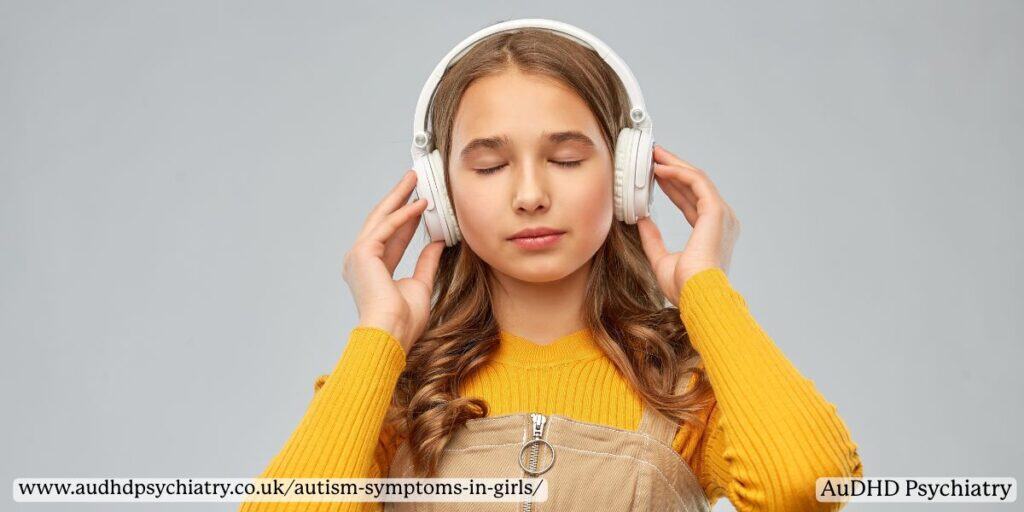
Autism in Teenage Girls and Emotional Regulation
During adolescence, autistic girls face new challenges as social communication becomes more complex. Puberty often intensifies emotions and sensory experiences, making stimming behaviours or withdrawal more noticeable. Many report feeling out of sync with peers, leading to isolation or self-esteem issues. Without the right support, these emotional pressures can contribute to anxiety or depression.
Because girls are often labelled as “sensitive” or “introverted,” their autism symptoms may continue to be overlooked. Teachers and health professionals might interpret their struggles as social anxiety or stress rather than indicators of a neurodevelopmental disorder.
High-Functioning Autism and Mild Presentations
Some girls display what’s commonly described as high-functioning autism, meaning they have strong language and cognitive skills but still experience difficulty with social communication and flexibility. These individuals often achieve academically yet find everyday interactions draining.
“Mild” autism doesn’t mean the challenges are insignificant. Many autistic women describe ongoing exhaustion from masking, managing sensory sensitivities, and misunderstanding in social settings. Over time, this can affect mental health, relationships, and overall quality of life.
Early Recognition and Support
Recognising autism signs in girls requires careful observation of both strengths and struggles. Early identification allows for personalised intervention that supports emotional regulation, learning, and independence.
For further insights into managing emotions and focus, see ADHD and Emotional Dysregulation. Understanding these overlapping traits between ADHD and autism helps create more inclusive, compassionate environments for autistic girls to thrive both in school and beyond.
Understanding Autism in Females
For decades, female autism was under-researched and misrepresented in diagnostic models built around boys [2]. Today, growing awareness helps us understand that women with autism often present differently, expressing autistic traits that are more internalised, emotional, or relational than behavioural.
How Autism Presents in Women
Women may appear socially capable, yet rely heavily on learned scripts or mimicry to manage conversations. Many also develop deep empathy but struggle to read social cues or maintain eye contact consistently.
Other common characteristics of autism in females include:
- Reliance on structure and predictability to reduce anxiety.
- Strong attention to detail and intense interests that provide comfort.
- Heightened awareness of social expectations, leading to perfectionism.
These adaptations often hide the underlying difficulties that healthcare providers may overlook during assessment. If you or a loved one may be experiencing similar struggles, seeking professional help might give you the answers you’ve been looking for. Book an autism assessment today with AuDHD Psychiatry, and our expert clinicians will guide you through every step of the process.
Why Awareness Matters
Many autistic women go undiagnosed until adulthood, only realising later that lifelong struggles with friendship, identity, and sensory sensitivities were linked to autistic traits. Without recognition, women may experience stress, burnout, or co-occurring mental health issues.
Improved awareness among teachers, clinicians, and families ensures that autism assessments consider gender differences in presentation. To explore related gender bias in neurodivergent diagnoses, read ADD vs ADHD.

Masking in Females and Being Autistic in Social Settings
One of the most defining aspects of being autistic as a girl or woman is masking—the effort to conceal or minimise autistic traits in social settings. Masking often begins in childhood as a survival strategy, helping girls blend in with peers or avoid stigma.
What Masking Looks Like
Masking may include:
- Rehearsing conversations before speaking.
- Forcing eye contact to appear “normal.”
- Copying gestures, expressions, or tone from others.
- Suppressing stimming behaviours such as fidgeting or humming.
Although these behaviours help autistic women navigate social challenges, they come at a cost. Prolonged masking often leads to fatigue, loss of identity, and higher risks of anxiety disorders.
The Emotional Impact of Masking
Masking requires constant vigilance, which can feel mentally exhausting. Over time, many women describe experiencing “autistic burnout”, which is a state of emotional depletion from continuous self-monitoring. Because masked behaviours can appear socially typical, even close family members may not realise how much effort goes into daily interaction.
Why Unmasking Matters
Recognising and reducing masking allows autistic women to reconnect with authentic behaviours and reduce stress. Supportive environments, whether at school, work, or home, can encourage self-acceptance and improve well-being.
Mild Autism and Late Diagnosis in Females
For many autistic women, diagnosis comes late in life—often after years of confusion, exhaustion, and self-blame. The term mild autism is sometimes used to describe individuals with fewer outward challenges, but it can be misleading. While a person may function well academically or professionally, internal struggles with social communication, sensory processing, and emotional regulation can still be significant.
Why Autism Is Often Overlooked in Females
Female autism often presents differently from the patterns described in traditional diagnostic criteria, which were developed through studies focused on boys. Girls are more likely to show autistic traits such as perfectionism, sensitivity, or quiet withdrawal—behaviours that may appear typical or even positive. As a result, many go undiagnosed until adulthood.
Contributing factors include:
- Social expectations that encourage girls to be polite, empathetic, or compliant.
- Differences in how autistic females express distress—often internalising rather than acting out.
- Limited awareness among health professionals about how autism presents in women.
The Emotional Toll of a Late Diagnosis
Living for years without understanding one’s autism symptoms can lead to mental health issues. A few examples of these are as anxiety, depression, and low self-esteem. Many women report a sense of relief after receiving a formal diagnosis, finally understanding the reason behind their social difficulties, sensory sensitivities, and fatigue.
The Importance of Professional Assessment
While online autism tests can provide insight into potential autistic traits, they should not replace professional evaluation. A full autism assessment carried out by qualified healthcare providers offers clarity and opens the door to support and workplace accommodations. If you have questions you’d like to ask a professional, book a free intro call with us today.
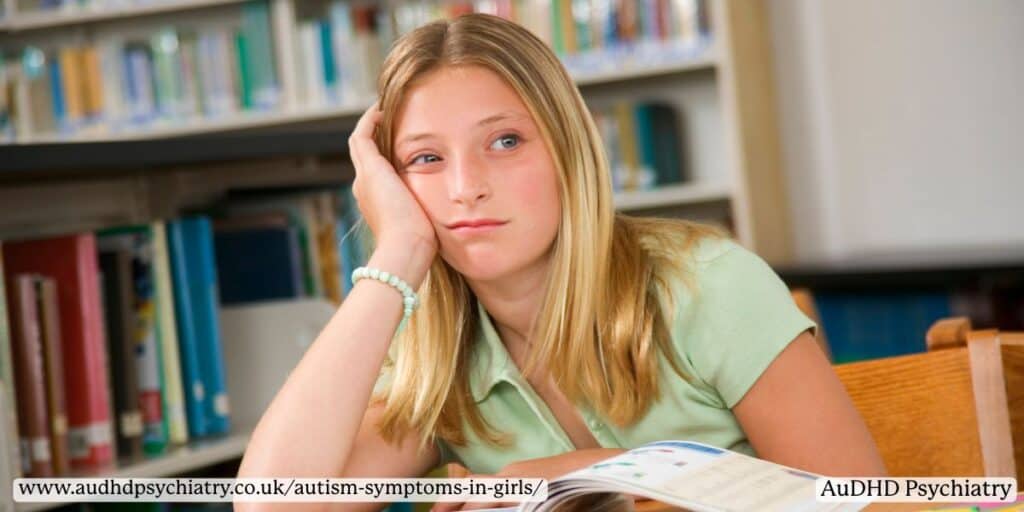
Impact of Undiagnosed or Unsupported Autism
When autism symptoms remain unrecognised, girls often grow up feeling different but never knowing why. Without support, many internalise frustration, overcompensate socially, or push themselves to exhaustion trying to “fit in.” These experiences have been seen to lead to chronic stress, anxiety disorders, and emotional burnout.
Unidentified autistic traits can also affect education and relationships. Teachers might misread daydreaming or social withdrawal as disinterest, and peers may misinterpret honesty as rudeness. Over time, this misunderstanding erodes self-esteem.
Many autistic women describe their eventual diagnosis as a turning point, bringing relief and self-understanding. Recognition enables access to emotional support, sensory accommodations, and therapy tailored to their needs. Early awareness helps prevent unnecessary suffering and encourages self-acceptance.
Are you experiencing challenges that may only partly relate to what we’ve shared here, and perhaps wondering if a different type of neurodivergent test might be appropriate for you? If so, we have a free ADHD test you might want to take. While this is not a formal diagnosis, it might help you decide whether it’s the right time to go for a full assessment.
Autism in Teenage Girls: Puberty and Emotional Changes
The teenage years can intensify autistic traits as hormonal and social pressures grow. Many autistic girls experience stronger reactions to sensory input, such as loud noises, perfumes, or fabric textures. These sensory shifts can make school environments draining and lead to withdrawal or anxiety.
During puberty, emotional responses become more complex. Autistic teenagers may struggle with emotional regulation, managing friendships, or adjusting to new expectations. Some mask harder to fit in, while others avoid social situations altogether.
Supportive guidance from parents, teachers, and clinicians can help. Providing predictable routines, quiet spaces, and clear communication reduces overwhelm. Conversations about sensory changes, self-care, and body awareness build resilience and confidence.
When these changes feel unmanageable, consulting healthcare professionals can ensure access to interventions that promote emotional stability and self-understanding.
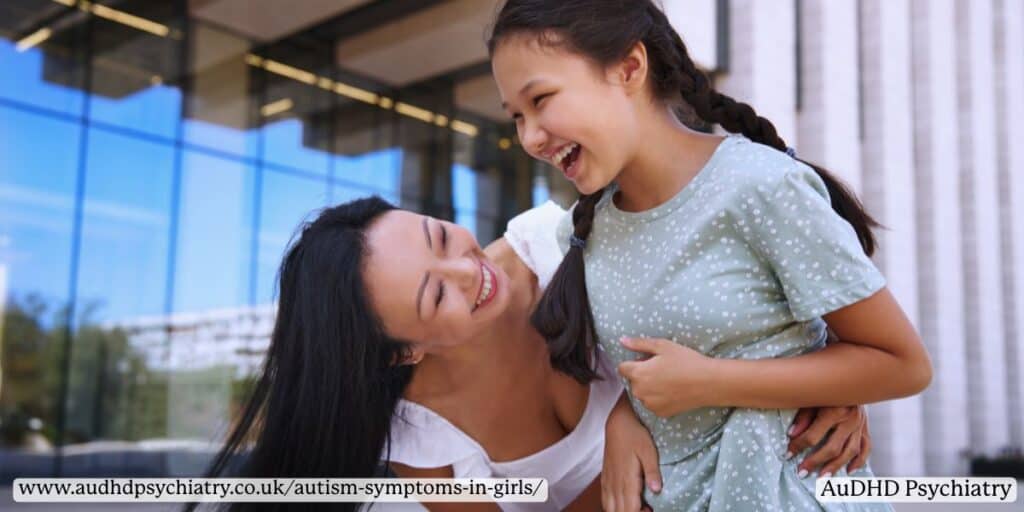
Seeking Help and Support
Recognising autism symptoms is only the first step. Accessing the right help makes all the difference. Early intervention and compassionate guidance from healthcare professionals can improve communication, emotional well-being, and learning outcomes.
Support may include:
- Educational adjustments, such as extra time or sensory-friendly classrooms.
- Therapeutic support, including occupational or speech therapy.
- Peer groups where autistic women and families share experiences.
Understanding available resources empowers families to act early. If you’re curious about the cost of a private autism assessment, check out this guide.
Supporting a Daughter Showing Signs of Autism
If you suspect your daughter may be autistic, early support can make a life-changing difference. Start by keeping detailed notes about her behaviour, such as social difficulties, sensory sensitivities, or repetitive patterns of play. This information helps healthcare professionals identify autism symptoms more accurately during the diagnosis process.
Parents can also:
- Speak to teachers or early years staff to understand behaviour in different settings.
- Discuss concerns with your GP or health visitor.
- Request a referral for an autism assessment if developmental differences persist.
Educating yourself about autistic traits helps reduce uncertainty and fear. Every child’s experience is unique. Whether your daughter receives a diagnosis or not, focusing on her emotional needs and creating a supportive environment builds confidence and resilience.
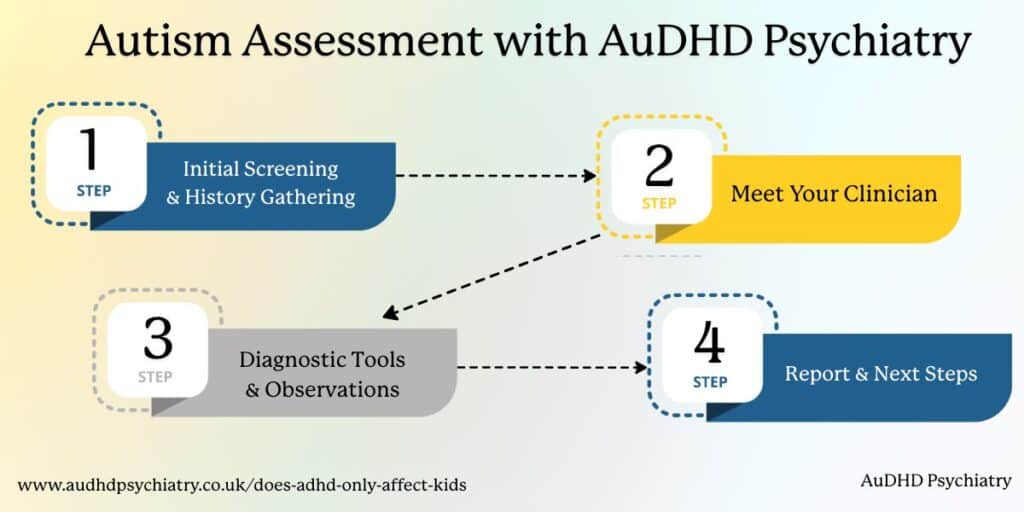
Getting an Autism Assessment with AuDHD Psychiatry
A professional autism assessment is the most reliable way to confirm whether your child meets the diagnostic criteria for autism. Assessments may take place through the NHS or privately, depending on waiting times and your family’s preferences.
Our process includes four key steps:
Step 1 – Initial Screening & History Gathering
You’ll complete secure online forms covering developmental history, education, health, and current support needs. If possible, an informant (such as a parent or partner) can provide additional background. Previous reports or diagnoses can also be uploaded.
Step 2 – Meet Your Clinician
In-depth sessions (video or in-person) explore social communication, flexibility, sensory processing, and lifelong patterns. We also consider masking behaviours and co-occurring conditions such as ADHD or anxiety.
Step 3 – Diagnostic Tools & Observations
Validated measures such as AQ-10, RAADS-R, CAT-Q, or ADOS-2 Module 4 are used where appropriate. Clinicians triangulate all findings against DSM-5 and ICD-11 criteria.
Step 4 – Report & Next Steps
You’ll receive a detailed report outlining findings, strengths, and recommendations for support at work, school, or home. Optional follow-up sessions are available for therapy, coaching, or referrals. A structured assessment helps ensure clarity, accuracy, and access to early intervention or workplace support.
Autism Symptoms in Girls: Conclusion
Awareness of autism symptoms in girls and women is improving, but recognition still lags behind male diagnoses. Understanding autistic traits, from social communication challenges to sensory sensitivitie , helps parents, educators, and adults seek the right support early.
If you or your child shows signs of autism, consider reaching out for professional guidance. Early diagnosis promotes understanding, reduces anxiety, and fosters personal growth. For expert-led evaluations, book with AuDHD Psychiatry. We’ll guide you through every step toward clarity, empowerment, and improved well-being.
References
- Gould, J. (2017). Towards understanding the under-recognition of girls and women on the autism spectrum. Autism, 21(6), 703–705. https://doi.org/10.1177/1362361317706174
- Hutson, P., & Hutson, J. (n.d.). Autism in Females: Understanding the overlooked diagnoses, unique challenges, and recommendations. Digital Commons@Lindenwood University. https://digitalcommons.lindenwood.edu/faculty-research-papers/492/
You Might Also Like
Contact Us
We’re here to answer any questions you might have.
Get in Touch
Opening Hours
Contact Form
We’re here to help. Reach out and we’ll get back to you within 24 hours (Monday – Friday).



